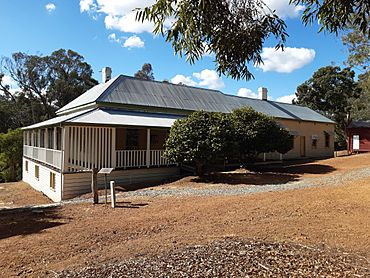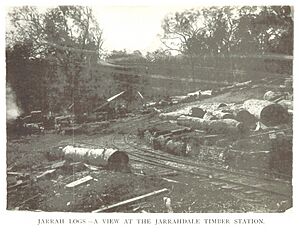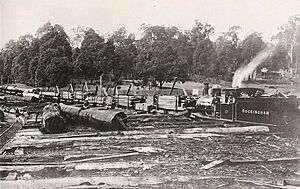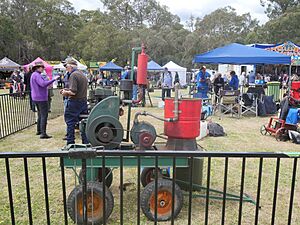Jarrahdale, Western Australia facts for kids
Quick facts for kids JarrahdalePerth, Western Australia |
|||||||||||||||
|---|---|---|---|---|---|---|---|---|---|---|---|---|---|---|---|

The heritage listed mill manager's residence in Jarrahdale
|
|||||||||||||||
| Postcode(s) | 6124 | ||||||||||||||
| Area | 256.4 km2 (99.0 sq mi) | ||||||||||||||
| LGA(s) | Shire of Serpentine-Jarrahdale | ||||||||||||||
| State electorate(s) | Darling Range | ||||||||||||||
| Federal Division(s) | Canning | ||||||||||||||
|
|||||||||||||||
Jarrahdale is a small, historic town in Western Australia. It is about 45 kilometers (28 miles) south-east of Perth, nestled in the Darling Range. The town's name comes from the jarrah forest, which is full of tall jarrah trees.
Jarrahdale started in the late 1800s as Western Australia's first big timber milling area. It was very important for the state's growth. Jarrah wood from here was sent all over the world. In 2016, about 1,192 people lived in Jarrahdale. Since 2001, the historic part of town has been looked after by the National Trust.
Contents
Jarrahdale's Story
How Jarrahdale Began
In the 1830s, people found sandalwood in the Jarrahdale area. A path was made to move the sandalwood to other towns. This path connected to what would become the Albany Highway and the South Western Highway.
From the 1830s to the 1850s, settlers moved into the areas around Jarrahdale. They grew vegetables and raised sheep. Wheat was also grown and turned into flour at a mill built by Joseph Batt. In 1862, the Gooralong Valley, where Jarrahdale is, had a huge flood. It rained over 650mm (25 inches) in four weeks!
The Timber Industry Takes Off
At first, it was hard to start a big timber business in Jarrahdale. This was because timber licenses were only for short periods. But then, the Governor of Western Australia, Frederick Weld, started giving out longer licenses. This made a group of investors from Victoria interested. In June 1871, they got a large piece of land and started the Jarrahdale Station Syndicate.
In June 1874, the Rockingham Jarrah Timber company took over the syndicate. This company was formed to work on land given to William Wanliss, one of the original investors. Wanliss became a manager for the new company. The company was based in Melbourne and sent jarrah wood to places like South Africa, Mauritius, New Zealand, and South Australia. They sent the wood through Rockingham.
To move the timber, another company, Jarrahdale Timber Coy, built a railway line. This line carried timber from Jarrahdale to Rockingham, passing through Mundijong.
By the mid-1870s, Jarrahdale had grown a lot because of the timber industry. It had 50 houses, a school, a store, a workshop, and a library. The Rockingham Jarrah Timber company owned these houses. Workers and their families lived there without paying rent until the early 1900s. By the mid-1880s, the town's population reached 400 people. About 180 of them worked for the company.
The community was lively with log chops and dances. Workers and their families often took trips to Rockingham. The first trip was on Western Australia Day in 1879. In 1886, the company opened the Murray Arms hotel. Jarrahdale grew even more when gold was found and demand for jarrah wood increased. In 1890, over 7,000 tons of jarrah from Jarrahdale were used in cities like Melbourne, Paris, London, and Glasgow.
The Rockingham Jarrah Timber company changed its name to Rockingham Railways and Jarrahdale Forests company. For years, people wanted a railway line between Bunbury and Perth. This line finally opened on September 8, 1893. It connected with the Jarrahdale-Rockingham railway at Mundijong, which was then called Jarrahdale Junction. After this, three more timber mills were built.
However, a bushfire in 1895 destroyed the original town. The town was then rebuilt west of its first spot, where it is today. After 1897, the company was renamed Jarrahdale Jarrah Forests and Railways Ltd. By 1898, Jarrahdale had 600 people. In 1899, about 300 men worked for the company. Jarrahdale's growth led to new buildings like a Wesleyan Methodist church, a school, a jail, a hospital, and a public hall. The post office and St Paul’s Anglican Church were built in 1896. The company owned almost every building in Jarrahdale.
Early 1900s Changes
By the 1900s, Jarrahdale's population reached 12,000 people. But other timber companies started to compete. In 1913, Jarrahdale officially became a gazetted town. In 1914, a Mechanics Institute was built, which is now called Bruno Gianatti Hall.
When World War I began, jarrah wood was used to build ports and harbors for the war effort. About 200 men from Jarrahdale joined the Australian Imperial Force to fight. Sadly, 41 of them died. Private Luke Siford was one of them; he joined in August 1915 and died during the Battle of the Somme. After the war, a war memorial was put up on February 10, 1923. It was later expanded to include those who died in World War II. In 2022, the memorial was updated with help from different groups.
After World War I, the demand for timber grew, and the mills produced more. Many Italian families moved to Jarrahdale after the war. Many of them worked on the railway lines. However, in the 1920s, one of the mills (No. 2 Mill) was destroyed. The Bush Landing school and the Roman Catholic church also closed in 1929.
When the Great Depression hit, the timber mills closed, and many people in Jarrahdale lost their jobs. In December 1929, the Jarrahdale Jarrah Forests and Railways Ltd. company's land agreement ended. The government also charged the company extra fees. As the Depression continued, the Millbrook Hotel closed but reopened in 1936 before closing for good in 1938. Many families left Jarrahdale to find work elsewhere. However, things got better when the No. 2 mill reopened.
During World War II, the mill stayed open. In 1943, a Prisoner of War (POW) camp was built south-east of Jarrahdale. It held 220 Italian POWs from North Africa. These prisoners helped by cutting firewood. By 1946, most of them had returned to Italy.
Modern Times in Jarrahdale
The Serpentine Dam was built and opened in 1961. This dam flooded the areas where the old No. 5 and 6 mills used to be. It also covered the abandoned settlement of Big Brook, which was once a part of Jarrahdale.
In the mid-to-late 1900s, Jarrahdale became important again for its natural resources. Bauxite was mined by Western Aluminium near Jarrahdale throughout the 1960s. Bauxite is an ore used to make Alumina. The ore was sent by train to Kwinana to be processed. In 1967, the company mined 405,000 metric tons of bauxite.
On July 14, 1997, the Jarrahdale townsite was added to the National Trust's List of Classified Heritage places. It was the seventh town in Western Australia to get this special recognition.
The Shire of Serpentine-Jarrahdale started a plan to improve the Jarrahdale Heritage Park. This park includes the old mill sites and the last mill that was built in the 1930s. This mill still operates as a small business called Heritage Sawmillers. It is located on the Gooralong Brook, which flows through the town. After talking with the landowners, the shire bought some land for new houses. In 2001, an entire historic area, including a closed timber sawmill, was given to the National Trust of Western Australia.
In 2008, the St Paul’s Anglican Church was moved to its current spot.
Surviving Historic Places
Along the main road, Jarrahdale Road, you can find the sites of the old timber mills. At the eastern end of town, the last mill site still has parts of its old buildings. This mill was run by Bunnings until 1997. An Alcoa alumina mining operation also finished in 1998. Both Bunnings and Alcoa took most of their equipment when they left.
The area around Jarrahdale has natural forests and steep hills. You can see parts of the old native forest, for example, near the Kitty's Gorge walk trail in the Serpentine National Park. In 2009, the Forest Products Commission announced plans to cut timber again in the area. They planned to log sites east of town where trees had regrown for 50 years.
There used to be many timber mills in the jarrah forest around Jarrahdale. Some of these were flooded when the Serpentine Dam was built between 1957 and 1961. Old railway tracks and cuttings show where past developments were. By the 1900s, Jarrahdale had about 1200 people in the town. Another 800 people lived in logging camps nearby. From 1925 to 1927, a special portable school was used. It was built on railway trucks so it could be moved easily by train. This allowed it to follow timber-cutters and their families as they moved through the forest.
Culture and Learning
The Serpentine-Jarrahdale Log Chop and the Serpentine-Jarrahdale Lions County Fair, often called the Jarrahdale Log Chop, is a yearly event. It takes place at Jarrahdale Oval, usually in late September or early October. It is a competition where axemen show their skills. The event started in the 1970s and is run by the Lions Club.
The first school in Jarrahdale opened in 1874. Today, the only school still open in town is Jarrahdale Primary School, which opened in 1954.
Getting Around Jarrahdale
Bus Services
- Route 253 goes from Jarrahdale to Armadale Station. It serves Kingsbury Drive and Jarrahdale Road.




